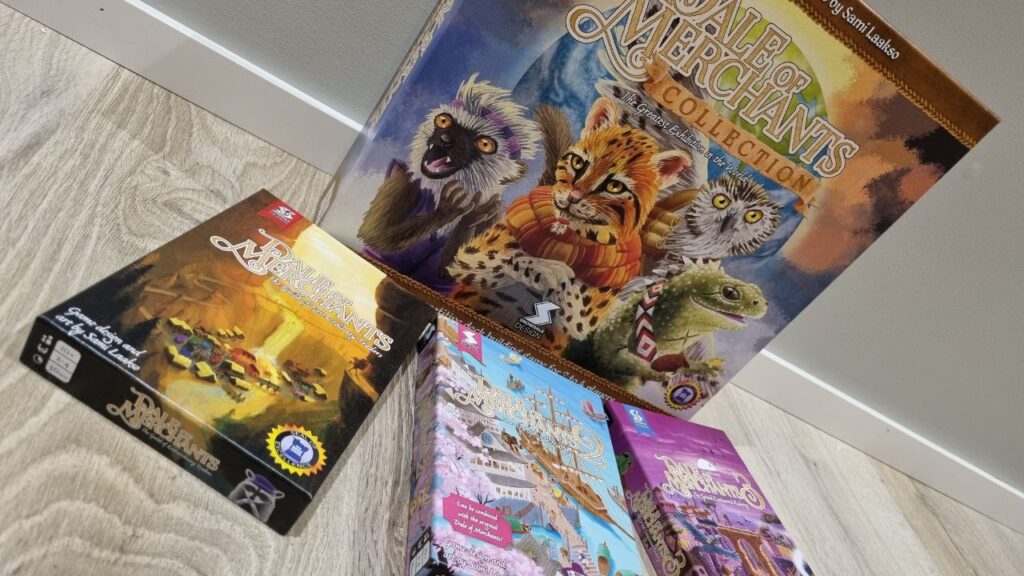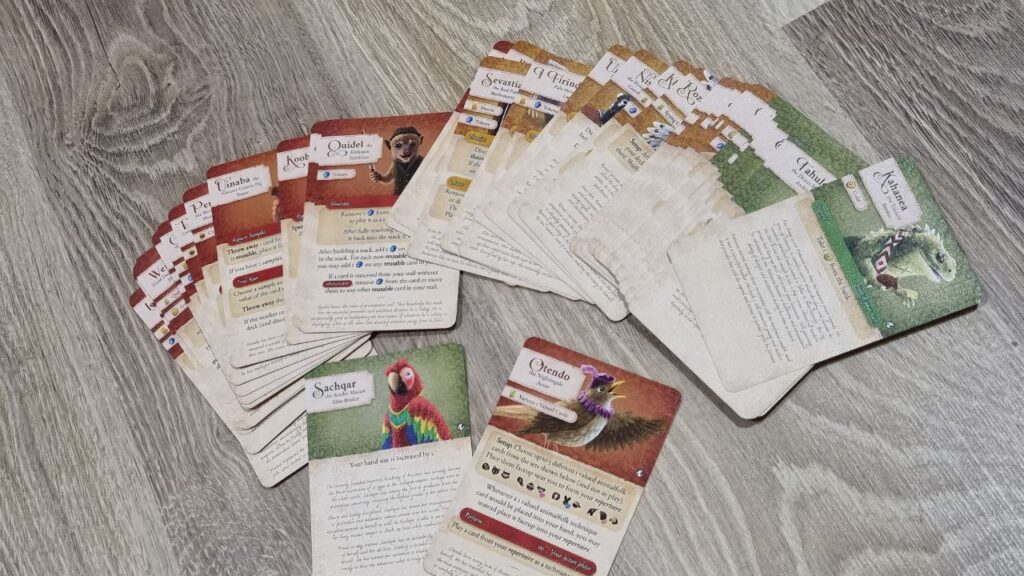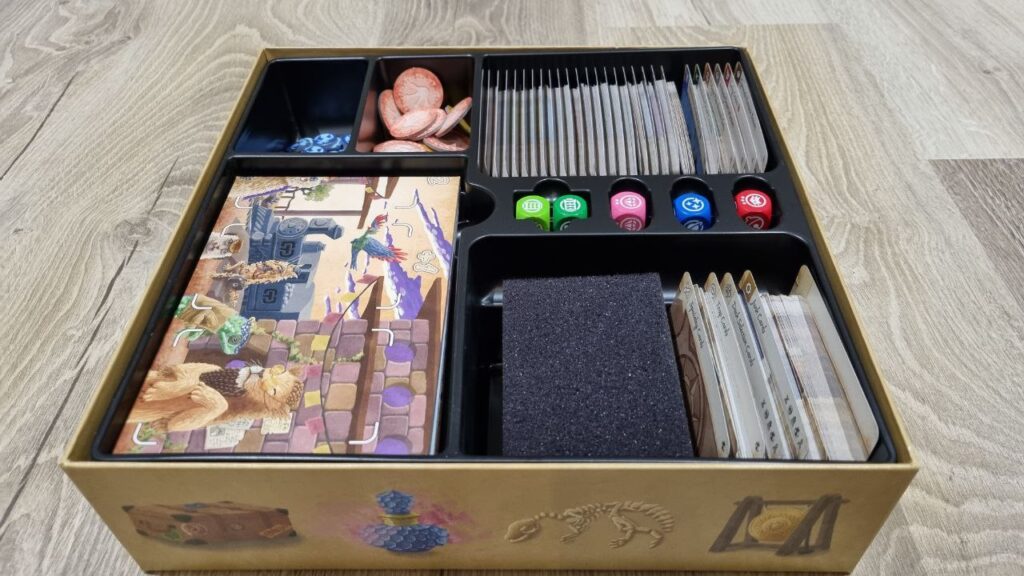I first played Dale of Merchants some years ago when a friend of mine brought it to a game night. The game somehow seemed to need more content – I remember immediately wanting more different cards in the game. Since then, the game has expanded with the three main games and through the Collection, which gathers other games together. There is also a mini extra. There must already be enough variation in these games – or is there? That will be revealed in this review.

Dale of Merchants is essentially a deck building game. The goal of the game is to join the merchants’ guild, and this is achieved by setting up eight stalls. As soon as someone succeeds in this, the game ends. You can set up a stall by placing cards equal to the rank of the stall to the stall. So you have to put a card with the number 1 in the first stall, you have to put cards with the total value of 2 in the second stall, and so on. More cards are purchased from the card market. When a card is bought from the market, it is filled with new cards. The market works in such a way that the most recently added cards are more expensive, but when the cheaper cards are removed, the more expensive cards become cheaper.
Players get to choose the decks included in the game themselves, which are illustrated by representatives of different animal races. Each deck has a slightly different theme – cards from one deck can change the order of the cards on the market, while another might introduce tease cards into play. Different decks of animals are chosen for the game – the amount is the number of players + 1. Each player gets one card from these decks, and the rest of the starter decks are filled with waste, which can (in principle) only be used to get new cards.

The game mechanics function well. It’s simple in concept, but versatile with different decks. In practice, a turn consists of one action, which is either buying a card, playing a card or setting up a stall. If you play a card, you may be able to chain more actions. And chaining cards together is always satisfying.
The game is fun to play. There are really different cards available in different decks. The cards have different functions, and higher value cards are generally more powerful. That is, a card of value 1 is usually simple and its effect is quite small, but a card of value 5 can mess up the whole game. These effects can be really radical – like exchanging the hand cards of two players. I don’t think the game should be taken too seriously, because with the different deck options, the game can be very chaotic. And this I do enjoy!

The game seems to end really abruptly. Suddenly, someone sets up the eighth stall, and the game ends. That’s it, nobody else can try to get a draw or anything. In a way, the game does not end out of the blue, because everyone sees when others set up their stalls, and can predict the victory of one of the players. But the end of even a potentially hectic game still feels like a sudden stop. In our gaming group, the thought arose: “Oh, was this it?”
A bit related to the two previous paragraphs, I feel that in the final stages of the game there is not much time to play different action cards, when you are in a terrible hurry to set up stalls that again eat your cards. When setting up a stall, the cards you played actually disappear from your hand and get stuck in the stall. In the game, you would like to play the interesting cards it offers, but in reality you have to use more cards for so-called for compulsive activities such as acquiring new cards or setting up stalls. In our games, it has happened that the players who have fun playing cards as activities do not necessarily do as well as the players who are boringly building their stalls. And this is a bit of a bummer. Fortunately, before doing the “boring activities”, you can also play cards, if the cards only enable the chaining of actions. However, in the late stages of the game, there are not necessarily many cards that can be used to play as actions, because you probably need the higher values of the most interesting action cards to buy other cards or set up stalls. The strongest time of the game is its beginning and middle stages, when you still collect a deck of cards and play actions. And the focus is not on setting up stalls. I myself have played the game with only four players, so it may be that you would have time to do things in the game completely differently if there are fewer players involved. But I haven’t tested this.

There are a huge number of different game variations. If you have acquired all the games in the Dale of Merchants series. Each main game comes with six animal packs, the Collection comes with eight and the mini addon comes with one. 27 different decks is a lot. On the other hand, if you have acquired, for example, only one Dale of Merchants main game, there are only 6 decks. So there is no variation at all. If you need variation in your game, you are almost required to get at least two games.
The theme of the game is really captivating. Animal themed games are always nice, and it works well when combined with this kind of fantasy world. The game also stands out in my opinion from other similar deck building games. Maybe it’s because of its colorful illustrations and great game packaging. The art style of the cards and animals itself is not to my taste, but in general the design of the cards and characters is otherwise really functional.

I also have to mention that if you have bought all the Dale of Merchants games, with the Collection, the other game boxes are useless, because you can put the cards from all the games in the Collection. This is of course a good thing in the sense that everything is collected in the same box with good dividers, sorted. So it’s every board player’s dream. However, I have to say that I’m a bit saddened by the fact that the Collection’s game box is definitely the dullest of the bunch, so in the name of logic I have to display it instead of the smaller and much more beautiful game boxes of the main series games. A small and personal criticism, but I wanted to bring out this aspect as well if you care about the general appearance of your (presumably Kallax) board game shelf.

Effort has been put into the game design in a way that I haven’t necessarily seen in any other game. The components are generally of high quality – except for the board that works as a market, which feels a bit flimsy and the coating at the folding point seems to be coming off without exception. In addition, the Collection brings with it a lot of material that shows the game developers’ love for the game. It includes, for example, a booklet with descriptions of different decks and ways to choose different decks faster according to the styles of different players. In addition, an application for choosing decks has been developed for the game, which makes it easier to choose the decks that are just right for your playing group. I really appreciate the effort put into the game.
Summary
Dale of Merchants is captivating, versatile and clearly loved by its developers, Snowdale Design. It has been developed with love and many add-ons show that the game is also popular among players. However, the game is not without problems. The game almost requires the purchase of several parts to guarantee versatility, the game seems to end in a really anticlimactic way, and during the game you have to spend an unfortunate amount of time on boring activities. Even though the game has its problems, and in terms of the review I aim for an objective review, you just want to like this game. So someone in the game’s atmosphere/game mechanics/holy power attracts me at least. And I can say that I’m happy to have several parts of the game sitting on my shelf.
PROS
- Well-functioning game mechanic
- Fun and chaotic gameplay
- Very many different game variations
- Enchanting theme
- All cards can be stored handily in Collection
- A lot of time and love has been spent on game design
CONS
- Game feels like it ends abruptly
- You need to spend a lot of time on boring actions
- Almost requires at least two games to keep the interest up
- The art style of the cards and animals isn’t to my taste


Pingback: Lands of Galzyr Review – What, an Open world board game? - Nerd Tales